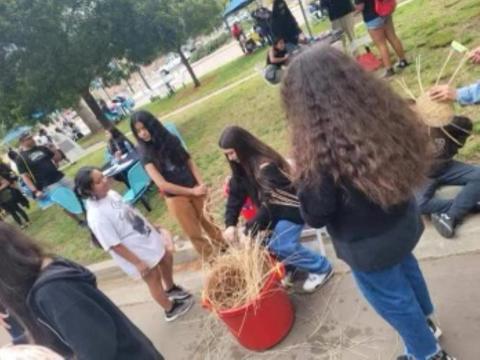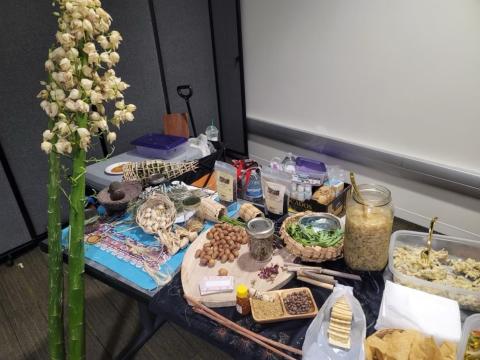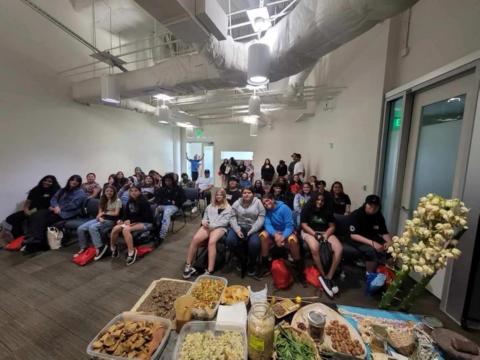The 15th annual Dream the Impossible Native Youth Conference was held at the University of California, San Diego in La Jolla on April 29. Open to middle and high school students, 33 youths that are part of the Soboba Tribal TANF program attended the all-day event.
DTI’s purpose is to encourage Native youth to dream big, to dream of becoming anything they want to be, and to dream of greatness. As long as youth have a dream, they will always have something to strive for in life.
Sandra Sandoval, Regional Compliance Officer for the TANF program, served as one of the chaperones. She enjoyed the encouraging and motivating words that many of the speakers shared with the students.
“This annual event is important as it allows the youth to step out of their comfort zones through engagement and networking with other youths,” Sandoval said. “The function serves as a stepping stone for the youth; therefore, it’s crucial for a college campus to host the event. It gives the youth a glimpse of college life on campus.”
Soboba Tribal TANF Transportation Coordinator Angelica Crawford agreed that it was an advantage for the students to be on a college campus, sitting in classrooms for breakout sessions and learning how to read a campus map, giving them a feel for college life.
“A highlight for me was watching the youth make memories,” she said. “One of our students had the chance to be on the campus of her dream school.”
During the conference, the chaperones assisted the young participants by guiding them to the many breakout sessions and activities offered throughout the day. “It is important for youth to attend these conferences because they hear the stories of speakers that started in their shoes,” Crawford said. “It’s not an easy road, but it is possible for them to achieve their goals.”
Ten breakout sessions were interspersed with cultural activities and a lunch break that incorporated a Resource Fair featuring a variety of community organizations, colleges and trade schools sharing information about different resources and options available to Native youth and families. Each youth was given the choice of three workshops to attend that covered a variety of topics.
Aleksia Rosas, 13, attended the “Pathways to Medical School” presented by the Association of Native American Medical Students at UCSD, which exists to support Native American medical students in completing health sciences curricula. They discussed their journeys to medical school, barriers they overcame and how a career in medicine can make meaningful changes in their communities.
She said she learned that not many Native Americans become doctors. “It makes me really think about my future and what I want to be. I really want to become a doctor,” Aleksia said.
Ariana Rosas, 16, learned that, “School is very important and there are many options to what you can do in college.”
Alayna Resvaloso-Wood, 16, said the conference experience taught her that “there’s often a lot of hardships before success.” She said she also learned that, “Just because your goals don’t happen instantly doesn’t mean that they won’t happen when you get older.”
A workshop Alayna particularly enjoyed was “Traditional Native Foods” presented by Blossom Maciel, who often hosts workshops at the Soboba Indian Reservation. Blossom taught how Native foods and plants can also be used as medicine and how to incorporate them into daily life.
Andrew Velazquez, 15, found the workshop subjects very interesting and really enjoyed the advice he got from the speakers at the “Native Youth Media/Vision Makers” session he attended, where he learned more about how movies are made.
Discussions included the ethics and responsibilities of storytelling. Participants were given hands-on video or photography experience into the creation of a story idea and structure, through writing a script, shooting, editing and sharing.
Andrew also attended “Native American College Life” where UCSD Native students explained the trials and triumphs of their college experience so far and college life in general. “Break Cycle Warriors” was his third session choice where he learned about the importance of physical, mental and spiritual health as presented by Bradley Guachino of the Pala Band of Mission Indians.
Ginger Velazquez, 14, also enjoyed the Native Youth Media session and said the most important thing she took home from the workshop is more confidence. “I heard someone say to never give up and that sometimes you have to get out of our comfort zone to do even better things,” she said.
Moyla Arviso, 14, was glad she was able to take home a lot of knowledge from attending the DTI conference for the first time. She chose to attend the “Anything is Possible” workshop with Destiny Ng, a Native Hawaiian from O’ahu. After graduating from the University of Redlands in 2020 with a degree in English Literature and a minor in Psychology, Destiny is now a full-time model. Utilizing a vision board, she taught participants how to find “your gifts and turn your dreams into a reality.”
Moyla chose this workshop because she enjoys doing these types of projects at school and she also likes to draw. The most important thing she learned at the conference is “how time is our most valuable resource.”
Su’la Arviso, 17, said the most important takeaway she had from attending this year’s conference is “to use your voice and stay dedicated to your goal; your future is everything.” One breakout session she chose to attend was “Indigenous Stories in AR, VR & Geolocation” but said all three of her choices represented the best fit for her and her current interests. She said the day-long experience taught her that, “We don’t really know how much time we have so why not live our life in a positive way and leave a positive impact on the world for future generations?”
Nowaniiki Resvaloso, 12, enjoyed the “Traditional Kumeyaay Games & Stories” session that gave participants the opportunity to join a fierce competition with their friends, playing traditional games while listening to Stan Rodriguez tell stories of Coyote the Trickster and other parts of the Creation story. Nowaniiki said one thing he heard at the conference that changed his way of thinking about his future was, “Try your best and keep going.”
Akwaalimay Resvaloso, 14, visited many of the different stations that were set up throughout the campus where flyers, brochures and other resource information was provided. She took home a lot of material for future reference.
There were also ongoing cultural activities that included beading by Gene Begay, a weaving circle by Blossom Maciel, information from the Sycuan Cultural Center, a Powwow dance by Mia Murillo and a presentation on Sustainable Farming Through Culture with Pauma Tribal Farms. Dodge ball and lawn games were offered, as well as campus tours.
The Dream the Impossible Youth Conference was started in 2007 by several Southern California Tribes and Tribal organizations. The dream began when local youth councils planned to organize a conference specifically for Southern California Native youth. After several planning meetings, the youth voted on a conference name and agreed to host the first ever Southern California Native Youth Conference on the Soboba Indian Reservation at Noli Indian High School and the Soboba Sports Complex.
The success of that first conference marked the beginning of the Dream the Impossible Native Youth Conference becoming an annual event. Today there are more than 35 Tribes, Tribal organizations and universities that contribute to the conference that is attended by approximately 500 Native youths each year.
Highlighting Dedication, Responsibility, Education, Attitude and Motivation, DTI’s message to youth is, “Don’t be afraid to DREAM!” For more information, www.dticonference.org.
Photos Courtesy of the Soboba Band of Luiseño Indians




